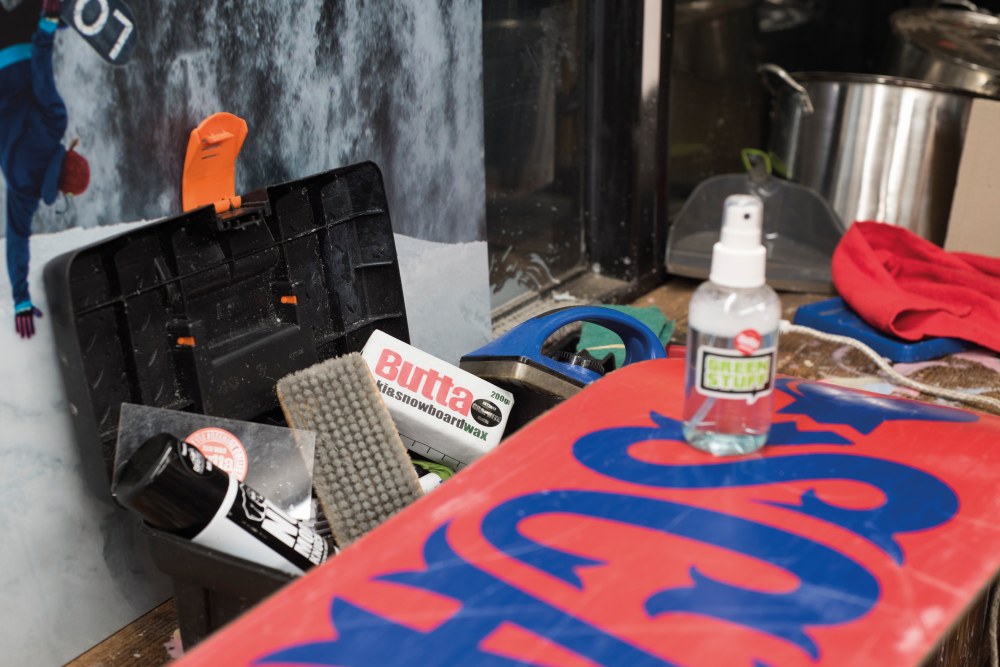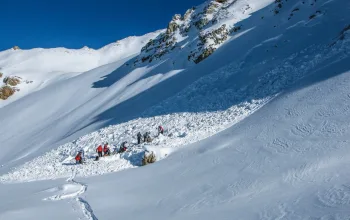 Step 1: Your workstation
Step 1: Your workstation
First find a stable work surface that’s roughly half to three-quarters the length of your snowboard. Workshop benches are ideal, coffee or kitchen tables are okay but beware, melted wax and wax shavings are messy and snowboard edges will scratch and scape most surfaces. The tools you’ll need are a stiff structuring brush, a wax scraper, snowboard wax and an iron – specialist wax irons are available but an old domestic one will do. Just don’t use it on your work shirts ever again! Once organised, remove your bindings.
 Step 2: Scrub your base clean
Step 2: Scrub your base clean
Before you can apply clean wax you need to remove all the old wax. Using a base cleaner and a cloth or a scotch pad, scrub the base clean. If you’ve got a brass base brush, you can use this to scrub off any excess wax and grime – again working from the nose to tail.
 Step 3: Wax the board
Step 3: Wax the board
With a waxing iron check the heat setting instructions on your wax packet. With a regular domestic iron, use the lowest setting which will just about melt the block of wax on contact with a slow drip. Once you’ve got the right temperature, drip a line of wax all around the edges of the board base. Then cover the middle by zigzagging from side-to-side along the board until it is evenly covered by drips of wax. Don’t drip too much on – you’re going to have to scrape it all off again soon.
 Step 4: Spread out the wax
Step 4: Spread out the wax
Using a small circular movement, spread out the wax over the whole base of the board. Make sure the whole board is covered, including the tips and tails – there isn’t a part of the board that you don’t use, so don’t be lazy! Don’t leave the iron in one place for too long, as the heat may damage the board. The wax you have just ironed should only be staying wet for two or three seconds after you move on. Any longer and you’re moving too slowly.
 Step 5: Scrape the wax off
Step 5: Scrape the wax off
Because the wax is a carrier for the products within it, the longer these have to penetrate into the base, the better. So ideally leave the wax to cool off overnigh, but if you’re in a hurry, leave it on for at least half an hour. After the cooling period, it’s time to scrape the wax back off again. Your scraper should have a 45 degree angle in the edge, so leaning the edge back towards the board, scrape firmly from nose to tail. Keep going until you can’t see any more wax on the board with the naked eye. Most scrapers will have a square cut out in the end. Use this to clean the wax off your edges – waxy edges won’t turn!
 Step 6: Finishing off
Step 6: Finishing off
The perfect finish to any wax job, is a good nylon brush. This will help remove any excess wax that wasn’t removed with the scraper. Use big long strokes, from tip to tail, leaving the finish on the board as good as new! A good test to see the benefits of waxing and ‘water-proofing’ of the base, is to pour a small amount of water onto the base, and watch it bead off. Now, the only job left to do is to find some snow, and go shred! Have fun!
Butta provide all the wax and waxing equipment you’ll need to take care of your board, including full sets with all the kit required for the tips above.
Photos: Simon Clark at sjclarkphotography.co.uk
















